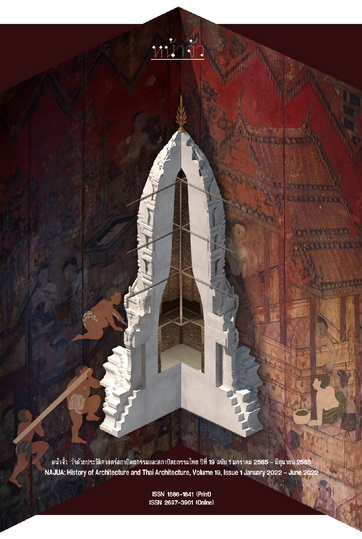Place Identity in Korat Town Through Ethnic Group Perspectives
Main Article Content
Abstract
This article explores the relationship among people who live in Korat Town where various ethnic groups, including Thai, Chinese-Thai, Thai–Mon, and Thai Sikhs, have inhabited from time to time. The research framework emphasizes the concept of place identity, focusing on the field research methodology by surveying place identity using the perception and understanding of meaning through the view of ethnic groups' experiences.
The results reveal that the Chinese-Thai descents perceive their identity through Bun Phaisan Shrine from the activities and symbolic meaning which reflect the Chinese-Thai community. The Thai perceive their identity through the use of surnames which indicates the person's origin as a symbol that conveys the identity of the Korat people. The Thai Sikhs have a perception of identity through Sri Guru Singh abha from their relationship with religious activities and the physical features of the place of worship which reflect the identity of the Thai Sikhs. The Thai–Mon descents recognize their identity through food culture linked to the way of life inherited from their ancestors.
Downloads
Article Details

This work is licensed under a Creative Commons Attribution-NonCommercial-NoDerivatives 4.0 International License.
References
Chalaem Phimpru. Thai. Interview, October 30, 2019.
Charnvit Kasetsiri. pramūan phǣnthī: prawattisāt-phūmisāt-kānmư̄ang kap latthi ʻānānikhom nai ʻĀsīan ʻusākhanē [Collected maps: History-geography-politics and colonialism in Southeast Asia]. Bangkok: The Foundation for the Promotion of Social Sciences and Humanities Textbooks Project, 2012.
Chitmanee Deeudomjant. Lecturer in Interior Architecture, Faculty of Art and Industrial Design, Rajamangala University of Technology Isan. Interview, October 10, 2019.
Chiwin Pestanyi, Bancha Nakthong and Prasit Tophoklang. sathāpattayakam rư̄an panyā læ rư̄an manilā nai khēt mư̄ang Nakhō̜n Rātchasīmā
[The architecture of hip roof and gable roof in Nakhon Ratchasima municipal]. Nakhon Ratchasima: Rajamangala University of Technology Isan, 2005.
Kachirat Nenloet. Thai–Mon. Interview, August 1, 2019.
Kamoltip Kasipar. Specialist in local vegetables and plants in Korat. Interview, December 13, 2019.
Kurabachansing Setthi. Thai Sikhs. Interview, January 28, 2020.
Marisa Hiranteeyakul and Nopadon Thungsakul. “kānsưksā ʻattalak thin thī nai singwǣtlō̜m san [The study of place identity in built environment].” Journal of Architectural Planning Research and Studies (JARS) 19, 1 (2022): 99-114.
Michael A. Wheeler. Martin Heidegger. Accessed December 19, 2021. Available from https://plato.stanford.edu/archives/fall2020/entries/heidegger
Muean Tangchoho. Thai. Interview, April 10, 2019.
Nakhon Ratchasima Chamber of Commerce. yō̜nrō̜i nưngrō̜i pī khōrātchawanit [The 100 years of Korat trader]. Bangkok: Future Press and Media, 1999.
Nakhon Ratchasima Provincial Cultural Center, Nakhon Ratchasima College of Teachers. nangsư̄ ʻān prakō̜p kān rīan watthanatham phư̄nbān čhangwat Nakhō̜n Rātchasīmā samrap chan matthayom pī thī nưng - sām: khō̜ngdī Khōrāt [Korat’s signature]. Nakhon Ratchasima: Nakhon Ratchasima Provincial Cultural Center, Nakhon Ratchasima College of Teachers, 1982.
Nakrob Narksuwan. “ʻattalak chāo Thai sik: kān sadǣng tūa ton nai sangkhom [Thai sikh’s identity: Self-expression in society].” Dusit Thani College Journal 11, Special Issue (May 2017): 377-390.
Nitthra Suwan. Thai–Mon. Interview, October 1, 2019.
Norberg-Schulz, Christian. Genius Loci: Towards a phenomenology of architecture. London: Academy Editions, 1980.
Norberg-Schulz, Christian. “Genius Loci: Towards a phenomenology of architecture (1979).” In Historic cities: Issues in urban conservation. Los Angeles: The Getty Conservation Institute, 2019.
Phra Phithak Yotha (Phithak Athinan), Major. banthưk kān song chāo Rāman (Mō̜n) khưn mā yū thī čhangwat Nakhō̜n Rātchasīmā nai pī Phō̜.Sō̜. sō̜ngphansāmrō̜isippǣt [The notes on mon in Nakhon Ratchasima]. Nakhon Ratchasima: n.p.,1963.
Pipu Boosabok. phatthanākān khō̜ng klum thun Čhīn nai phāk ʻĪsān tō̜n bon khō̜ng prathēt Thai Phō̜.Sō̜. sō̜ng phansīrō̜ičhetsipsī- ō̜ngphanhārō̜i hāsipkāo [Development of Chinese capital in the upper Isan region of Thailand 1931-2016]. Bangkok: The Thailand Research Fund, 2017.
Proshansky, Harold M. “The city and selfidentity.” Environment and behavior 10, 2 (June 1978): 147-169.
Relph, Edward. Place and placelessness. London: Pion, 1976.
Rueangrawi Nirantechaphat. Thai Sikhs. Interview, September 15, 2022.
Saowakhon Ueaurailoet. Chinese-Thai. Interview, December 7, 2018.
Scannell, Leila and Robert Gifford. “Defining place attachment: A tripartite organizing framework.” Journal of Environmental Psychology 30, 1 (March 2010): 1-10.
Suriya Samutthakhot. rāingān kānwičhai rư̄ang withī khit khō̜ng Khon Thai: phithīkam khūang phī fō̜n khō̜ng Lāo khāočhao čhangwat Nakhō̜n
Rātchasīmā [Cultural constructs of local knowledge: Ethnic Thai-Lao spirit-medium cults in Khorat villages]. Nakhon Ratchasima: Suranaree University of Technology, 1997.
Thanongsak Hanwong. Former Technical Officer, Fine Arts Department. Interview, April 18, 2019.
Wimon kitwanitkhachon. “khō̜i bō̜ chai Lāo ʻattalak Thai Khōrāt [Khoi Bo Chai Lao-Thai identity in Korat].” Matichon Suk San [Matichon] (May 2000): 12.


